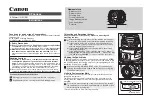
52
Piranha2 User’s Manual
Oil is usually introduced during handling. Touching the surface of the window
barehanded will leave oily residues. Using rubber fingercots and rubber gloves can
prevent oil contamination. However, the friction between the rubber and the window
may produce electrostatic charge that may damage the sensor. To avoid ESD damage and
to avoid introducing oily residues, only hold the sensor from the edges of the ceramic
package and avoid touching the sensor pins and the window.
Scratches can be caused by improper handling, cleaning or storage of the sensor. Vacuum
picking tools should not come in contact with the window surface. CCDs should not be
stored in containers where they are not properly secured and can slide against the
container.
Scratches diffract incident illumination. When exposed to uniform illumination, a sensor
with a scratched window will normally have brighter pixels adjacent to darker pixels. The
location of these pixels changes with the angle of illumination.
5.3 Cleaning the Sensor Window
1.
Use compressed air to blow off loose particles. This step alone is usually sufficient to
clean the sensor window.
2.
If further cleaning is required, use a lens wiper moistened with alcohol or acetone.
3.
We recommend using lint-free ESD-safe cloth wipers that do not contain particles that
can scratch the window. The Anticon Gold 9”x 9” wiper made by Milliken is both ESD
safe and suitable for class 100 environments. Another ESD acceptable wiper is the
TX4025 from Texwipe.
4.
An alternative to ESD-safe cloth wipers is Transplex swabs that have desirable ESD
properties. There are several varieties available from Texwipe. Do not use regular
cotton swabs, since these can introduce charge to the window surface.
5.
Wipe the window carefully and slowly.
6.
When cleaning long linear sensors, it may be easier to wipe along the width (i.e. as
opposed to the length) of the sensor.
03-32-00493-11
DALSA
















































